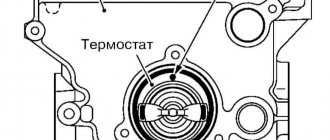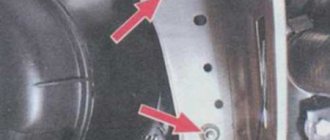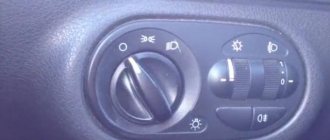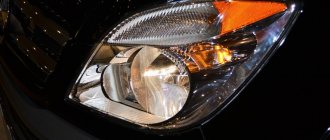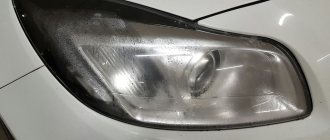Foggy headlights are a serious problem. Headlights can sweat even on new cars, and there are several reasons for this. Ignoring the problem can affect not only additional costs, but also ride comfort. So how to fix this problem? Find out from this article.
To properly troubleshoot the problem, you need to know the reasons for the appearance of water in the headlights. The reasons may be the following:
- Clogged hole in the ventilation system. There are two breathers inside the headlights through which air is ventilated. The hole may become clogged with debris from under the hood or during repairs, which is very rare.
- The light bulb was replaced incorrectly. Everything is simple here. The little paw stands crookedly in its hole.
- Cracks appeared in the glass. This can happen due to an accident or improper installation of the structure. Through the gap, moisture will always get inside the headlight.
- The sealant has dried out. Sealant tends to dry out over time. Depressurization can also occur due to an accident.
- Defective headlights. Cases are very rare. The glass may be crooked or have incorrect geometry.
- The hydraulic corrector is broken. Failure of the device results in leakage of liquid, which can get inside the headlight.
Foggy headlight
The fogging is so strong that it does not even allow you to determine the type of headlight.
The fogging is so strong that it does not even allow you to determine the type of headlight.
Generally speaking, absolutely all headlights and other car lights are a priori leaky. It cannot be otherwise: when heated, the temperature inside any headlight can easily change by 100 degrees! From minus 35, achievable in winter even in central Russia, to 60–70 degrees with the headlights on in the summer, in the sun. In addition, the rear part of the headlight is located in the engine compartment, where, as a rule, it is quite hot. At the same time, the air in the headlight naturally expands, and therefore cannot be avoided without exchange with the external environment.
Where there is contact, there is always the possibility of fogging. For example, if a cooling headlight sucks in moist air - say, at a car wash, then the transparent cap (previously it was a diffuser) according to the laws of physics has the right to become somewhat cloudy. Well, if the headlight has defects, then it has a much higher chance of fogging up. The once beloved Volga of one of the authors began to attract attention because the headlight glasses behaved differently - one was more transparent than the other. Soon everything became clear: during a visit to the service, one diffuser fell off by itself!
Is fogging dangerous? Without a doubt. It distorts the light distribution, which disturbs both the driver (the illumination of the road decreases) and other road users (it blinds them).
How to overcome fogging of headlights and flashlights
Many car owners have experienced fogging of headlights and taillights. If condensation that appears from the inside on the glass of lighting devices disappears soon after the headlight or lantern is turned on, it is treated as an annoying misunderstanding. However, moisture is not always so easily dealt with, and then it becomes a problem that has at least two serious consequences.
Firstly, when mixed with dust, which can also penetrate the headlight or flashlight, moisture initiates corrosion, which affects metal parts and electrical connections. This can lead to damage to the mirror coating of the reflectors to the point where it is necessary to replace the reflector, failure of electric corrector motors, xenon headlight ignition units, light bulbs and other components.
Secondly, the quality of light that the headlights are supposed to provide deteriorates. Each droplet is a miniature lens that refracts and scatters the light beam that the headlight should form. As a result, road illumination deteriorates, which in itself does not contribute to traffic safety, and also causes the driver to strain his eyesight and get tired faster during the trip.
There are known cases when fogging of the headlights became the reason for the car’s refusal to pass inspection. There is a solid basis for this in the traffic rules, recorded in the list of faults, which prohibits the participation of vehicles in road traffic if there are objects (liquids) not intended by the design inside the optical elements of their lighting devices.
We talk about the causes of fogging and ways to get rid of this problem with Yuri Borisenko, a specialist in the repair and adjustment of automotive lighting equipment :
— I can not only tell you, but also show you why headlights and lanterns fog up. For example, recently an owner who had imported an Infiniti from Russia approached me with this problem.
What immediately caught my attention was that the sweating headlight was set with gaps that should not have been there if the car had not been in an accident. Since there was an impact, it means that the headlight housing could have been damaged and lost its seal.
I lifted the hood and saw that the headlight was not even screwed to the body. But they didn’t screw it on because the hole in the headlight ear did not coincide with the base hole for attaching the ear to the body. If they started to tighten the eyelet with a bolt, something would break. As a result, whoever did the renovation left the place as is.
But elsewhere the repairmen did their best. Due to the impact, the wing mount cross member moved 2-3 centimeters to the side, so the factory mounts did not line up. Instead, two new holes were drilled for non-standard bolts and nuts. Since the signs of an accident were obvious, I began to look for a crack in the headlight housing.
I didn't have to search for long. From my experience I can say that in no less than 90 percent of cases it is damage that causes fogging of headlights and flashlights. Whether this problem can be overcome depends on the nature of the damage. A crack or small chip can be repaired with a soldering iron, glued or covered with silicone - depending on the owner, that’s up to you.
What is noteworthy in this case is that not only did a crack appear on the headlight due to the impact, but the mounting lugs also broke off. It is clear that they were restored, but why they did not repair the crack on the body is a question. This often happens: they repair a headlight, but they do it thoughtlessly. The ear was restored, but they ignored the fact that there was a crack - it was small and didn’t seem to affect anything. But it was through it that water got into the headlight in the rain and during washing.
Other causes of fogging relate to problems with the ventilation of headlights and lanterns, or to factory defects in sealing the joint between the glass and the housing, leaky fastening of light bulbs, electrical correctors, and casings covering the compartment where the lamps are located.
In this particular case, Infiniti had to remove the vapor barrier membrane from the headlight breather. Lighting devices are equipped with breathers so that the housing is ventilated from the inside and so that the air expanded from heating has the opportunity to escape from the headlight. When the headlight cools down and the air inside is compressed, the part of it that was forced out when heated returns to the headlight through the ventilation ducts. The purpose of the membrane is to prevent humid and dusty street air from entering the headlight. Air passes through, moisture and dust remain on the membrane.
Over time, the membrane becomes clogged. The headlight stops ventilating, and this is also the cause of fogging. If you try to blow out the membrane, but it tries to inflate like a balloon, then it needs to be changed. But try to find a repair kit.
Therefore, they usually follow a simple procedure - remove the membrane altogether. Such membranes are an example of Japanese engineering excellence. It turns out that there are plenty of eccentrics in Japan too. In addition to the fact that the membrane performs its function only for a few years and then becomes unusable, in the headlights of Japanese cars you can often see only one breather, although, in my deep conviction, there should be at least two of them - at the bottom of the headlight and at the top, for convection to occur. At the same time, on the casting of the headlight housing there may be places for two or three air vent valves, but for some reason they are muffled. Then you can drill a hole - the headlight will begin to “breathe” normally, which helps to cope with fogging.
Non-Japanese manufacturers usually do not suffer from this. Their headlights and lanterns have as many breathers as needed; the breathers themselves are a simple rubber U-shaped elbow, sometimes with a piece of foam rubber inside. So, when removing the membrane, there is no need to be afraid that dust will flow into the headlight. The experience of other manufacturers shows that a simple breather without any membranes copes with its task quite well - the headlight is ventilated and does not sweat, dirt does not penetrate into it, the breather itself is almost eternal.
As for the factory defect in the leaky fastening of the casing covering the compartment where the lamps are located, again, I recently had one Volkswagen.
There were signs of an accident under the hood, but when I removed the headlight and began to inspect it, I found no damage to the body. I assumed that the leak appeared at the junction of the glass and the body. I don’t know what kind of sealants some manufacturers use to glue glass to the body, but often after some time the sealant dries out, cracks appear in it, and when you start to detach the glass, the sealant falls out like dust.
True, in this case the sealant had nothing to do with it. I poured water into the headlight and it didn't leak anywhere. This means that there are no leaks between the glass and the body. I dried the headlight, assembled it and began to pour water on it from the outside until condensation appeared on the glass from the inside.
I dried the headlight again and carefully opened the lamp compartment. There were traces of leakage on its lid.
The problem was caused by a “chewed” rubber seal. In my opinion, this is a design flaw. It was possible to install the lid tightly only after several attempts - the rubber band kept trying to twist out and “escape” from its place. I have no doubt that when it is necessary to replace a burnt-out lamp in a headlight in order to hermetically close the lamp compartment, the headlight will have to be removed - you can’t do this correctly on a car, no matter how hard you try.
Also in the same Volkswagen there was water in one of the fog lights. Everything turned out to be simple with her.
I removed the fog light and found a hole in the upper part of the housing. I sealed it with silicone - water stopped flowing into the headlight. Generally speaking, it is not always so easy to deal with the problem. It happens that you find several obvious reasons and eliminate them, but the headlight continues to fog up. This means that there is something else that is not visible to the naked eye. Diagnostics is needed, and in the case of fogging, it only consists of pouring water into the headlight or watering the outside of the headlight and then looking for leaks. After fixing the problem, it is important to completely dry the headlight using a household hair dryer, or, if carefully, a technical one. Moreover, if it is easy to remove moisture from the internal space of the headlight housing, then for hidden cavities, which are electric motors and other components, a long “frying” with a hairdryer will be required.
Our verdict
The main reason for fogging of lighting equipment is mechanical damage to headlights and lanterns. In addition, lighting devices can fog up if there are problems with housing ventilation and sealing the joint between glass and housing, due to leaky fastening of light bulbs, electrical correctors, and casings covering the compartment where the lamps are located. It is possible to defeat fogging, but to do this, in each specific case, you need to find all the reasons why water penetrates inside the device.
Sergey BOYARSKIKH Photos by the author and Yuri BORISENKO ABW.BY
Cloudy headlight
The low beam of Largus's headlights is greatly distorted.
The low beam of Largus's headlights is greatly distorted.
At the same time, increased humidity inside the headlight housing destroys the coating of the reflectors. Well, there’s nothing to say about electrics: water and contacts will never make peace.
If the headlight is working properly, then, in general, there is nothing to be afraid of. The fogging will disappear as quickly as it appeared. The headlight, as we already mentioned, in cheap designs there is a tube directed downward, while more modern cars use special breathers with small filters for ventilation.
Why is it necessary to troubleshoot?
Water in the optics unit is extremely undesirable and even dangerous. Here are just a few consequences:
- rapid wear of reflectors;
- frequent failure of light bulbs and diodes;
- there is a high probability of moisture getting on the wires, which leads to their oxidation and may result in a short circuit.
A beam of light passing through glass clouded by condensation turns out to be dimmer and more diffuse. Water droplets become an additional lens that changes the direction of light. Visibility is greatly impaired, which is very dangerous when driving in the dark or in poor visibility. For this reason, the car may be refused registration with the traffic police.
Headlights or taillights that regularly accumulate water will not last long because they operate in very unfavorable conditions . If the reflective coating is damaged, the scratches will begin to oxidize and the reflective film will bubble, which can no longer be eliminated. The entire optics unit will need to be replaced, which is not cheap. Also, water getting on hot light bulbs shortens their service life. Lamps and diodes burn out more often and also require replacement. Connectors oxidized due to moisture damage the entire headlight. Often, water-damaged wires cause a short circuit, which has serious consequences and can even cause a fire. Therefore, fogging of the headlight from the inside, especially regular and severe, cannot be ignored, but should be eliminated as quickly as possible.
headlight
Fog light Kia cee'd.
Two breathers are clearly visible. One for each section. Fog light Kia cee'd. Two breathers are clearly visible. One for each section.
What faults can cause fogging? Everything is simple here: most often the ventilation is simply clogged with dirt. Headlights with cracks also “walk on their own.” Some cases of fogging are associated with unprofessional disassembly/assembly of the headlight.
In such cases, there is only one piece of advice. Repair the headlight until all joints are sealed, so that only the standard “breathers” remain. If this does not work, the headlight must be replaced. No desiccant in the form of silica gel or pieces of diaper will help a faulty headlight.
And yet, how dangerous are drops of water caught in a headlight? We carried out a simple experiment: using a syringe we pumped 20 ml of water into the optics of the editorial Largus - this is quite a lot. We turned on the headlights, waited, then turned them off - well, yes, the hubcaps became cloudy. The light distribution became ugly. However, after a couple of days, after a relatively short run, the effect disappeared: the water safely evaporated into the atmosphere. Which, in fact, was what needed to be proven.
Of the useful tips regarding anti-fogging, we will mention, perhaps, only one: be careful when washing the engine compartment under pressure. A strong jet can rip off the “breathing caps” and cause trouble, after which you will have to seriously tinker with the headlight or replace it altogether.
How condensation forms
Fogging of car optics is associated with the appearance of condensation inside the headlight unit. Water that gets inside for various reasons begins to evaporate under the influence of heated lamps and settle in the form of droplets on the inner surface of the headlight. The glass becomes cloudier, and the light passing through it becomes dull and diffuse. Water drops act like a lens, changing the direction of light.
Fogging of headlights is a problem that requires the attention of the car owner
Fogging results in poor visibility. This is especially dangerous at night or in poor visibility conditions.
Chevrolet Cobalt
The breathers of the Chevrolet Cobalt are sealed with blue non-woven material to prevent dust from entering.
The breathers of the Chevrolet Cobalt are sealed with blue non-woven material to prevent dust from entering.
Tell us in the comments if you have ever encountered fogging of lighting devices and how you dealt with this phenomenon.
Foggy headlight: treat or replace?
Do-it-yourself removal of fogging
At home, eliminating fogging of headlights is possible when the reason why condensation accumulates is discovered. Microcracks in the plastic of the headlight cannot be seen, because the surface of the structure is corrugated, there are decorative bends, etc. The structure sweats over the entire surface. To check the unit, you need to remove the headlight from the car:
- disconnect the terminals from the battery;
- disconnect the light bulbs;
- clean the body;
- check the sealing of the seams.
If the headlights are fogged up due to torn seams, it is necessary to completely remove the old glue, dry the headlight from condensation, and degrease the surface. To avoid the question of how to seal the headlights, use a silicone-based sealant.
Depressurization of the connecting seam of the connected turn signal is one of the common causes of sweating. It is necessary to check the seam between the glass and the body, contact exit points, plugs, and drainage channels.
Immerse the optics in a bowl of water. If bubbles are observed, there is a crack in the block. If the glass is cracked, the part will sweat systematically, regardless of the weather and temperature. It is necessary to seal the area with a colorless sealant.
If the headlights in Japanese cars fog up, then when you examine the inside of the body you will see only one breather and two sealed plugs. The part cannot “breathe” properly, hence the constant sweating. It is necessary to make optimal ventilation of the housing - drill an additional hole.
What to do with foggy car optics? And should we pay attention to this?
Foggy headlight: treat or replace?Danger of fogging
If the headlights sweat from the inside, the danger for the driver and pedestrians is obvious: the illumination of the road is distorted. In addition to safety issues, the defect will not allow the driver to pass inspection. According to traffic regulations, any malfunctions in the lighting system are excluded. In addition, a sweating part will lead to the following problems:
- Corrosion of the internal parts of the block.
- A halogen lamp may burst if a drop of moisture falls on its heated surface.
- The electrical wiring contacts will short out if a large amount of condensate systematically accumulates in the part.
- The appearance of the car suffers: foggy optics are simply ugly.
Today there are enough ways to dry a headlight in the garage without removing it or with dismantling and complete self-diagnosis of the glass and housing. In 70 cases out of 100, simply re-gluing the structure is enough to restore the insulation. If the unit is damaged after a strong impact, it is better to replace the optics with a new one.
Headlights sweat from the inside - finding and eliminating the cause
It is important to remove the consequences, but the main thing is to remove the source of the problem: treating with sealant, sealing the crack, replacing the part, cleaning the ventilation valve, sealing the wire/lamp inputs.
To detect a defect, conduct a thorough inspection of the element for chips or cracks.
Check the functionality of the valves. Clean them and replace the foam. If they are defective, new parts must be installed. Apply sealant if you find a problem with the seal. Make sure there is a gasket in the area where the lamp adheres to the body. If necessary, buy or make a new one from scrap materials.
After repair, test the entire device by placing it glass side down in water (do not wet the breather outlets).
Why do headlights sweat from the inside - types of lamps
We have already written that halogen products get very hot - this often leads to the formation of condensation due to temperature changes. Xenons and LEDs spend much less energy, so they are “cooler”. The air exchange here is significantly lower - the light elements “fog up” less intensely.
In any case, regardless of the chosen lighting option, “fogging” of the light block cannot be neglected.
If the unpleasant “cloudy” effect does not go away within 30 minutes, you need to take action as quickly as possible.
You can use glue/tape/film against cracks and chips, but only as a temporary measure. Look for the cause and eliminate it without bringing the situation to a critical level.
Why do car headlights sweat - what problems does a car owner face?
In practice, moisture in the front elements refracts the light flux so much that a car with such a defect cannot be driven. This is especially true at night. If you add to this a layer of dirt (for example, dust), then you will be driving “blind”.
Be sure to inspect the car before driving. If you decide to fix the problem yourself, be careful: find and watch a video with detailed instructions. Be careful not to damage fragile parts.
If you don’t understand why your car’s headlights are sweating from the inside, contact a car service center. To search, use the Uremont.com aggregator. There is an online application form for an instant solution to the problem and a chat with professionals to clarify the nuances.
Proper cleaning and assembly
- It is advisable to clean the disassembled headlight from dust and dirt. Glass and reflectors must not be washed with aggressive detergents or hot water. The best solution is a solution of laundry soap and a soft, lint-free rag. Don't rub!
- Then the washed components should be rinsed generously with distilled water and left to dry naturally.
- Assembly is carried out using clean cotton gloves. A special sealant for headlights is applied to the seam (at this stage you need to work carefully and avoid breaking the lines of the composition).
- The glass is connected to the body and dried at room temperature for 24 hours.
- Then you can check the tightness. To do this, the headlight is immersed with glass in water and held for several minutes. In this case, water should not get into the holes on the back wall.
How to get rid of problems if headlights sweat: video about cleaning ventilation ducts
You can eliminate fogging of the head optics yourself. The main thing is to take your time and choose the right materials. Prevention is even more important. You should periodically check that the breathers are clogged. Try not to drive at high speed through puddles with your headlights on, and let the headlights cool down before visiting a car wash. Then the headlights will fog up less often and you won’t have to remove them for drying.

